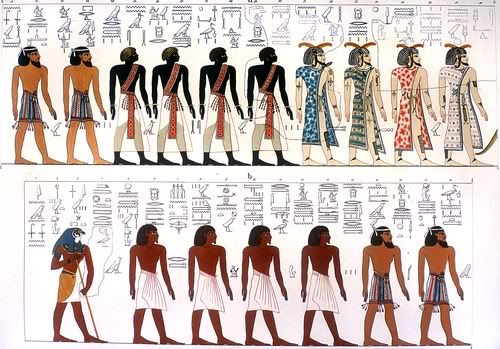The Geographical Origins and Population Relationships of Early Ancient Egyptians
Professor S.O.Y. Keita
Department of Biological Anthropology
Oxford University
Professor A. J. Boyce
University Reader in Human Population
Oxford University
What was the primary geographical source for the peopling of the Egyptian Nile Valley? Were the creators of the fundamental culture of southern predynastic Egyptwhich led to the dynastic culturemigrants and colonists from Europe or the Near East? Or were they predominantly African variant populations?
These questions can be addressed using data from studies of biology and culture, and evolutionary interpretive models. Archaeological and linguistic data indicate an origin in Africa. Biological data from living Egyptians and from skeletons of ancient Egyptians may also shed light on these questions. It is important to keep in mind the long presence of humans in Africa, and that there should be a great range of biological variation in indigenous "authentic" Africans.
Scientists have been studying remains from the Egyptian Nile Valley for years. Analysis of crania is the traditional approach to assessing ancient population origins, relationships, and diversity. In studies based on anatomical traits and measurements of crania, similarities have been found between Nile Valley crania from 30,000, 20,000 and 12,000 years ago and various African remains from more recent times (see Thoma 1984; Brauer and Rimbach 1990; Angel and Kelley 1986; Keita 1993). Studies of crania from southern predynastic Egypt, from the formative period (4000-3100 B.C.), show them usually to be more similar to the crania of ancient Nubians, Kushites, Saharans, or modern groups from the Horn of Africa than to those of dynastic northern Egyptians or ancient or modern southern Europeans.
Another source of skeletal data is limb proportions, which generally vary with different climatic belts. In general, the early Nile Valley remains have the proportions of more tropical populations, which is noteworthy since Egypt is not in the tropics. This suggests that the Egyptian Nile Valley was not primarily settled by cold-adapted peoples, such as Europeans.
Art objects are not generally used by biological anthropologists. They are suspect as data and their interpretation highly dependent on stereotyped thinking. However, because art has often been used to comment on the physiognomies of ancient Egyptians, a few remarks are in order. A review of literature and the sculpture indicates characteristics that also can be found in the Horn of (East) Africa (see, e.g., Petrie 1939; Drake 1987; Keita 1993). Old and Middle Kingdom statuary shows a range of characteristics; many, if not most, individuals depicted in the art have variations on the narrow-nosed, narrow-faced morphology also seen in various East Africans. This East African anatomy, once seen as being the result of a mixture of different "races," is better understood as being part of the range of indigenous African variation.
The descriptions and terms of ancient Greek writers have sometimes been used to comment on Egyptian origins. This is problematic since the ancient writers were not doing population biology. However, we can examine one issue. The Greeks called all groups south of Egypt "Ethiopians." Were the Egyptians more related to any of these "Ethiopians" than to the Greeks? As noted, cranial and limb studies have indicated greater similarity to Somalis, Kushites and Nubians, all "Ethiopians" in ancient Greek terms.
There are few studies of ancient DNA from Egyptian remains and none so far of southern predynastic skeletons. A study of 12th Dynasty DNA shows that the remains evaluated had multiple lines of descent, including not surprisingly some from "sub-Saharan" Africa (Paabo and Di Rienzo 1993). The other lineages were not identified, but may be African in origin. More work is needed. In the future, early remains from the Nile Valley and the rest of Africa will have to be studied in this manner in order to establish the early baseline range of genetic variation of all Africa. The data are important to avoid stereotyped ideas about the DNA of African peoples.
The information from the living Egyptian population may not be as useful because historical records indicate substantial immigration into Egypt over the last several millennia, and it seems to have been far greater from the Near East and Europe than from areas far south of Egypt. "Substantial immigration" can actually mean a relatively small number of people in terms of population genetics theory. It has been determined that an average migration rate of one percent per generation into a region could result in a great change of the original gene frequencies in only several thousand years. (This assumes that all migrants marry natives and that all native-migrant offspring remain in the region.) It is obvious then that an ethnic group or nationality can change in average gene frequencies or physiognomy by intermarriage, unless social rules exclude the products of "mixed" unions from membership in the receiving group. More abstractly this means that geographically defined populations can undergo significant genetic change with a small percentage of steady assimilation of "foreign" genes. This is true even if natural selection does not favor the genes (and does not eliminate them).
Examples of regions that have biologically absorbed genetically different immigrants are Sicily, Portugal, and Greece, where the frequencies of various genetic markers (and historical records) indicate sub-Saharan and supra-Saharan African migrants.
This scenario is different from one in which a different population replaces another via colonization. Native Egyptians were variable. Foreigners added to this variability.
The genetic data on the recent Egyptian population is fairly sparse. There has not been systematic research on large samples from the numerous regions of Egypt. Taken collectively, the results of various analyses suggest that modern Egyptians have ties with various African regions, as well as with Near Easterners and Europeans. Egyptian gene frequencies are between those of Europeans and some sub-Saharan Africans. This is not surprising. The studies have used various kinds of data: standard blood groups and proteins, mitochondrial DNA, and the Y chromosome. The gene frequencies and variants of the "original" population, or of one of early high density, cannot be deduced without a theoretical model based on archaeological and "historical" data, including the aforementioned DNA from ancient skeletons. (It must be noted that it is not yet clear how useful ancient DNA will be in most historical genetic research.) It is not clear to what degree certain genetic systems usually interpreted as non-African may in fact be native to Africa. Much depends on how "African" is defined and the model of interpretation.
The various genetic studies usually suffer from what is called categorical thinking, specifically, racial thinking. Many investigators still think of "African" in a stereotyped, nonscientific (nonevolutionary) fashion, not acknowledging a range of genetic variants or traits as equally African. The definition of "African" that would be most appropriate should encompass variants that arose in Africa. Given that this is not the orientation of many scholars, who work from outmoded racial perspectives, the presence of "stereotypical" African genes so far from the "African heartland" is noteworthy. These genes have always been in the valley in any reasonable interpretation of the data. As a team of Egyptian geneticists stated recently, "During this long history and besides these Asiatic influences, Egypt maintained its African identity . . ." (Mahmoud et al. 1987). This statement is even more true in a wider evolutionary interpretation, since some of the "Asian" genes may be African in origin. Modern data and improved theoretical approaches extend and validate this conclusion.
In summary, various kinds of data and the evolutionary approach indicate that the Nile Valley populations had greater ties with other African populations in the early ancient period. Early Nile Valley populations were primarily coextensive with indigenous African populations. Linguistic and archaeological data provide key supporting evidence for a primarily African origin.
References Cited:
Angel, J. L., and J. O. Kelley, Description and comparison of the skeleton. In The Wadi Kubbaniya Skeleton: A Late Paleolithic
Burial from Southern Egypt. E Wendorf and R. Schild. pp. 53-70. Dallas: Southern Methodist University Press. 1986
Brauer, G., and K. Rimbach, Late archaic and modern Homo sapiens from Europe, Africa, and Southwest Asia: Craniometric comparisons and phylogenetic implications, Journal of Human Evolution 19:789-807. 1990
Drake, St. C., Black Folk Here and There, vol 1. Los Angeles: University of California. 1987
Keita, S.O.Y., Studies and comments on ancient Egyptian biological relationships. History in Africa 20:129-154. 1993
Mahmoud, L. et. al, Human blood groups in Dakhlaya. Egypt. Annuals of Human Biology. 14(6):487-493. 1987
Paabo, S., and A. Di Rienzo, A molecular approach to the study of Egyptian history. In Biological Anthropology and the Study
of Ancient Egypt. V. Davies and R. Walker, eds. pp. 86-90. London: British Museum Press. 1993
Petrie, W.M., F. The Making of Egypt. London: Sheldon Press. 1984
Thoma, A., Morphology and affinities of the Nazlet Khaterman. Journal of Human Evolution 13:287-296. 1984

 I mean that's just the reality of it (in the social sense). A more scientific statement would be that they were indigenous Northeast Africans.
I mean that's just the reality of it (in the social sense). A more scientific statement would be that they were indigenous Northeast Africans.  Just more of the double standard reinforcing your mindset.
Just more of the double standard reinforcing your mindset.







